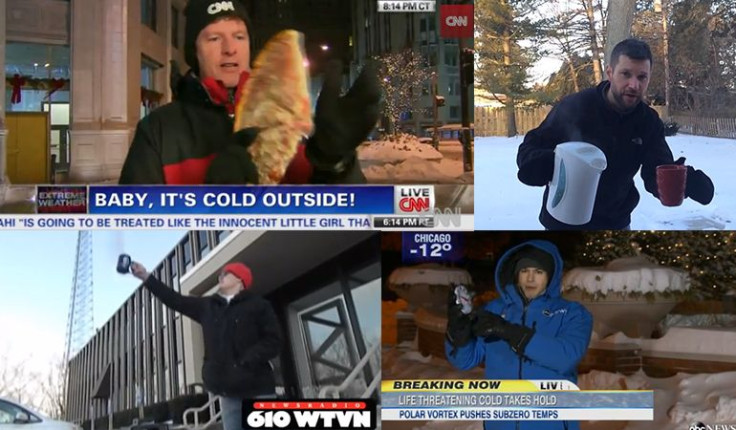Make The Most Of ‘Polar Vortex:’ Here Are 5 Fun Science Experiments To Try In Cold Weather [VIDEOS]

By now, you’ve probably heard about the “polar vortex” currently making things pretty miserable for nearly 240 million Canadians and Americans.
The “polar vortex,” a name given to the circulation of strong, upper-level winds normally found around the North Pole, has thrown North America into a pit of blistering cold weather. Starting Monday, Midwest and East Coast residents were plunged into sub-freezing temperatures as the cold front crept further into the U.S. Now, half the country is shivering amid arctic temperatures.
Some areas of the country are experiencing a level of cold not felt in decades. In Chicago, temperatures plummeted to minus 16 degrees Fahrenheit. According to the Los Angeles Times, Texas and Oklahoma experienced record-setting cold, with wind chills dipping below minus 40 degrees Fahrenheit. Even in Georgia, a state known for its humid subtropical climate, temperatures dropped to minus 6 degrees Fahrenheit in its northern mountains.
Many people are stuck indoors after schools and offices were closed because of the frigid conditions. If cabin fever is beginning to set in, or if seasonal affective disorder has you down, here are five cold-weather experiments you can try at home to bide the time until spring.
Super Soaker Experiment
This one’s an easy one, and won’t take very much preparation time. All you need is a super soaker and some lukewarm water. Fill the super soaker up, take it outside and watch the water turn to vapor!
How does it work? When water that is warmer than the air around it is introduced to the cold, it freezes into tiny ice crystals. Keep in mind, the warmer the water, the faster it freezes (not that we recommend putting boiling water into a super soaker).
Shrinking Balloons
If you’re something of an aspiring magician, this one’s for you. All you have to do is inflate a balloon while still indoors, then take it outside. Like “magic,” the balloon will deflate. Bring it back indoors and voila! The balloon will be back to normal.
How does it work? Gas – in this case, the air inside the balloon – shrinks and expands as its density increases and decreases, respectively. When a gas at a lower density (i.e. inside your warm house) is introduced to the cold, its density will quickly increase, causing the balloon to appear as if it’s shrinking.
Frozen Bubbles
Blowing bubbles is a great summertime activity. No Fourth of July block party would be complete without them.
But bubble-blowing doesn’t have to be confined to the dog days of summer. During cold weather, watch what happens when bubbles are blown and allowed to freeze.
Maple Syrup Candy
Live Science noted that a fun way to take advantage of the cold weather is to turn it into an excuse to make your own candy. How about giving maple taffy a shot?
All you need to do is heat butter and maple syrup together, allow it to cool, and then pour the liquid into fresh snow (we recommend making little “cups” in the snow with your fingers and sticking toothpicks or straws into the mix to create maple syrup pops).
Here’s a recipe to get you started.
Soda Slushy
In cold weather, there’s no reason to run down to 7 Eleven for a Slurpee. It’s freezing outside – make your own!
Here’s how:
© Copyright IBTimes 2024. All rights reserved.






















